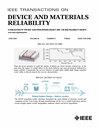Probing the Atomic-Scale Mechanisms of Time-Dependent Dielectric Breakdown in Si/SiO2 MOSFETs (June 2022)
IF 2.5
3区 工程技术
Q2 ENGINEERING, ELECTRICAL & ELECTRONIC
IEEE Transactions on Device and Materials Reliability
Pub Date : 2022-06-29
DOI:10.1109/TDMR.2022.3186232
引用次数: 2
Abstract
We report on an atomic-scale study of trap generation in the initial/intermediate stages of time-dependent dielectric breakdown (TDDB) in high-field stressed (100) Si/SiO 2 MOSFETs using two powerful analytical techniques: electrically detected magnetic resonance (EDMR) and near-zero-field magnetoresistance (NZFMR). We find the dominant EDMR-sensitive traps generated throughout the majority of the TDDB process to be silicon dangling bonds at the (100) Si/SiO 2 interface (探索Si/SiO2 mosfet中随时间变化的介电击穿的原子尺度机制(June 2022)
我们报道了在高场应力(100)Si/SiO2 mosfet中,使用两种强大的分析技术:电检测磁共振(EDMR)和近零场磁电阻(NZFMR),在时间相关介电击穿(TDDB)的初始/中间阶段产生陷阱的原子尺度研究。我们发现在大多数TDDB过程中产生的主要edmr敏感陷阱是(100)Si/SiO2界面(${\boldsymbol {P}}_{\boldsymbol {b} \boldsymbol{0}}$和${\boldsymbol {P}}_{\boldsymbol {b} \boldsymbol{1}}$中心)上的硅悬浮键,用于自旋依赖重组(SDR)和陷阱辅助隧道(SDTAT)过程。我们发现这一代与计算界面态密度的变化以及界面上重组事件的NZFMR谱的变化有关,表明移动磁核的重新分布,我们得出结论,这只能是由于氢在界面上的重新分布。此外,我们观察到在较低实验温度下,通过界面处的SDR测量,在EDMR测量中产生了称为$\boldsymbol {E}'$中心的陷阱。我们的工作强烈地表明,在界面上产生的硅悬空键和整个氧化物产生的硅悬空键之间的隧道过程中,涉及到一个限速步骤。
本文章由计算机程序翻译,如有差异,请以英文原文为准。
求助全文
约1分钟内获得全文
求助全文
来源期刊

IEEE Transactions on Device and Materials Reliability
工程技术-工程:电子与电气
CiteScore
4.80
自引率
5.00%
发文量
71
审稿时长
6-12 weeks
期刊介绍:
The scope of the publication includes, but is not limited to Reliability of: Devices, Materials, Processes, Interfaces, Integrated Microsystems (including MEMS & Sensors), Transistors, Technology (CMOS, BiCMOS, etc.), Integrated Circuits (IC, SSI, MSI, LSI, ULSI, ELSI, etc.), Thin Film Transistor Applications. The measurement and understanding of the reliability of such entities at each phase, from the concept stage through research and development and into manufacturing scale-up, provides the overall database on the reliability of the devices, materials, processes, package and other necessities for the successful introduction of a product to market. This reliability database is the foundation for a quality product, which meets customer expectation. A product so developed has high reliability. High quality will be achieved because product weaknesses will have been found (root cause analysis) and designed out of the final product. This process of ever increasing reliability and quality will result in a superior product. In the end, reliability and quality are not one thing; but in a sense everything, which can be or has to be done to guarantee that the product successfully performs in the field under customer conditions. Our goal is to capture these advances. An additional objective is to focus cross fertilized communication in the state of the art of reliability of electronic materials and devices and provide fundamental understanding of basic phenomena that affect reliability. In addition, the publication is a forum for interdisciplinary studies on reliability. An overall goal is to provide leading edge/state of the art information, which is critically relevant to the creation of reliable products.
 求助内容:
求助内容: 应助结果提醒方式:
应助结果提醒方式:


